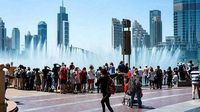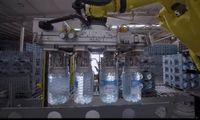The fast-growing tourism and non-oil sectors in the UAE are making waves, with new trends emerging and further driving economic growth.
In recent years, especially during the current winter and spring seasons, the travel industry in the United Arab Emirates has seen substantial growth. Local tourism has gained remarkable traction, attributed mainly to the region's mild weather that has persisted longer than ever, enticing both residents and international visitors alike. Executives in the travel and tourism sector have noted that this extended pleasant climate supports longer travel durations, boosting local attractions and capturing the interest of many.
"What we’ve seen in the latter part of last year and early January resembles a strong seasonal wave, even during Ramadan, with occupancy rates in Dubai surpassing 80%, a record number,” stated Mamoun Hmaidan, CEO of Wejgo. As the good weather continues, the trend is expected to extend into April, redefining the peak travel periods that previously ended in March.
This year alone, Dubai has welcomed a surge of 18.72 million international visitors, marking a 9% increase from the previous year. This statistic not only surpassed the past record of 17.15 million visitors in 2023 but illustrates Dubai’s steady rise as a favored tourist destination, particularly in the colder months.
The campaigns organized by the Dubai Corporation for World Tourism, particularly the 2024 campaign titled "Dubai, What’s Not To Love?" and the recently launched “If You Go, You Know” initiative, which encourages residents to explore and showcase their favorite landmarks, have significantly contributed to the city’s appeal to tourists.
While the tourism sector flourishes, local businesses like the water bottling company Masaafi have been resilient pillars in the local economy for decades. Founded nearly 50 years ago, Masaafi has navigated the changing market dynamics by not only focusing on product quality but also on cultural resonance and local engagement.
"Masaafi was built in the Emirates and for the Emirates. This foundation impacts every decision we make, from how we source water to how we interact with consumers," said Saud Al-Ghurair, the President of Masaafi. Their commitment to honoring local culture is showcased through various initiatives, including their special Ramadan collaboration with Emirati artist Mariam Abbas to create a bespoke water bottle design—an homage to the rich traditions of the Emirates.
The upcoming generation of consumers demands more from brands, expecting them to contribute meaningfully to their community and reflect local values. This shift is why many businesses, including Masaafi, are focusing on local partnerships and investments. Al-Ghurair noted, "We invest in local talents and collaborate with local suppliers to celebrate our culture properly. This commitment resonates within our broader mission of connecting people through hydration during cultural moments."
As tourism enhances the economy, the UAE is also seeing exciting projections for overall economic growth. According to Standard & Poor's Global Market Intelligence, non-oil economic growth in the UAE is forecasted to reach 5.2 percent in 2025, fueled by booming industries like tourism, real estate, and services. Ralph Wiegert, Head of the Middle East and North Africa Division at Standard & Poor’s, emphasized the importance of the real estate market in this context, clarifying that the sector is expected to continue as a key driver of growth going into the next year.
"We haven’t seen any signs indicating an imminent slowdown in the market. Further growth in Dubai’s real estate sector is expected, which signals a continued confidence in the market," said Wiegert.
This encouraging backdrop highlights the efforts made by the UAE to innovate within its economy, particularly through technological advancement. Kristalina Georgieva, Managing Director of the International Monetary Fund, anticipates that the benefits of digital innovation and developments in AI will significantly bolster the UAE’s GDP by 2030, along with robust investment in research and development to improve productivity.
However, the economy still faces risks, particularly in the oil sector, where adjustments to production quotas from OPEC+ can create volatility. There are rumors that OPEC+ might increase oil output for the second consecutive month by 135,000 barrels per day as early as May 2025, a potential factor that could either stabilize or add uncertainty to the economic forecasting. This heightened production may assist in GDP growth but may also lead to tighter fiscal policies if oil prices decline further.
As these factors converge, what remains clear is that UAE's economy is not only diversifying beyond oil but flourishing. From tourism driving the service sector to local brands like Masaafi embracing cultural and community responsibilities, it seems the future is bright for the region.





